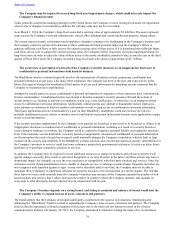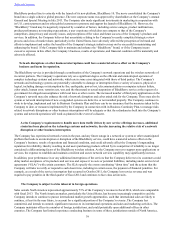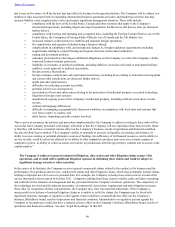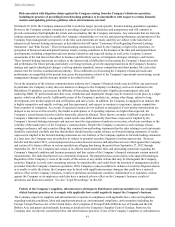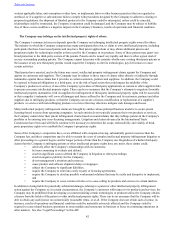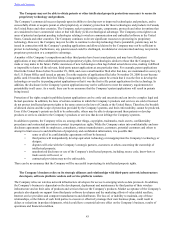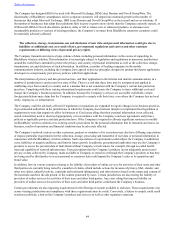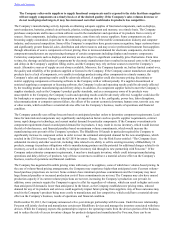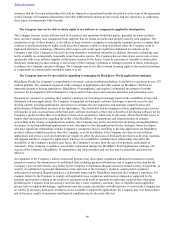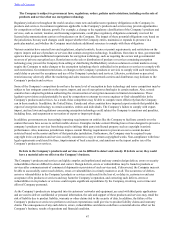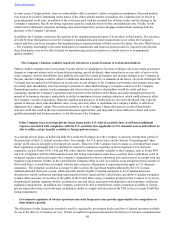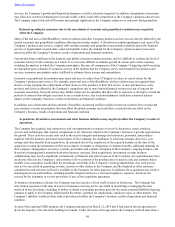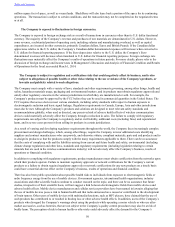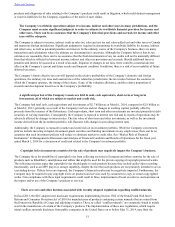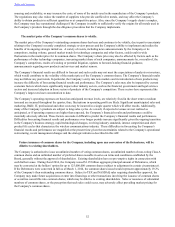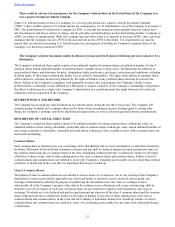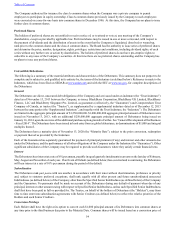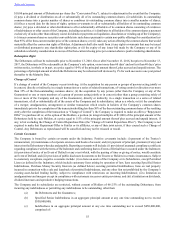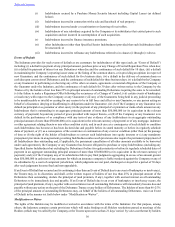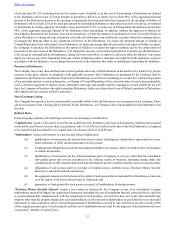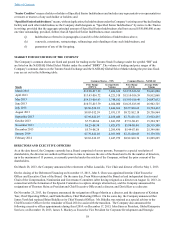Blackberry 2014 Annual Report Download - page 56
Download and view the complete annual report
Please find page 56 of the 2014 Blackberry annual report below. You can navigate through the pages in the report by either clicking on the pages listed below, or by using the keyword search tool below to find specific information within the annual report.
48
In some cases, if design defects, errors or vulnerabilities affect a product’s safety or regulatory compliance, then such product
may need to be recalled. Depending on the nature of the defect and the number of products, the Company may be forced to
incur substantial recall costs, in addition to the costs associated with the potential loss of future orders and the damage to the
Company’s reputation. Recalls involving regulatory agencies could also result in fines and additional costs. Finally, recalls
could result in third-party litigation, including class action litigation by persons alleging common harm resulting from the
purchase of the Company’s products.
In addition, the Company outsources the majority of the manufacturing and repair of its products to third parties. The resources
devoted by these third parties to meet the Company’s manufacturing and repair requirements is not within the Company’s
control and there can be no assurance that manufacturing or repair problems will not occur in the future. See also “Risk Factors
-- The Company increasingly relies upon third parties to manufacture and repair its products and it is exposed to the risk that
these third parties may not be able to satisfy its manufacturing needs and repairs on a timely basis or to an appropriate
quality standard.”
The Company’s business could be negatively affected as a result of actions of activist shareholders.
Publicly-traded companies have increasingly become subject to campaigns by investors seeking to advocate certain governance
changes or corporate actions such as financial restructuring, special dividends, share repurchases or even sales of assets or the
entire company. Activist shareholders have publicly advocated for certain governance and strategic changes at the Company in
the past, and the Company could be subject to additional shareholder activity or demands in the future. Given the challenges the
Company has encountered in its business in recent years, recent changes to the Company’s governance and strategic focus may
not satisfy such shareholders who may attempt to promote or effect further changes, or acquire control over the Company.
Responding to proxy contests, media campaigns and other actions by activist shareholders would be costly and time-
consuming, disrupt the Company’s operations and would divert the attention of the Board and senior management from the
pursuit of its business strategies, particularly its ability to implement its new strategic initiatives, which could adversely affect
the Company’s results of operations, financial condition and prospects. If individuals are elected to the Board with a specific
agenda to increase short-term shareholder value, it may adversely affect or undermine the Company’s ability to effectively
implement the Company’s plans. Perceived uncertainties as to the Company’s future direction as a result of shareholder
activism could also result in the loss of potential business opportunities, and may make it more difficult to attract and retain
qualified personnel and business partners, to the detriment of the Company.
If the Company loses its foreign private issuer status under U.S. federal securities laws, it will incur additional
expenses associated with compliance with the U.S. securities laws applicable to U.S. domestic issuers and will not be
able to utilize certain benefits available to foreign private issuers.
As a foreign private issuer, as defined in Rule 3b-4 under the Exchange Act, the Company is currently exempt from certain of
the provisions of the U.S. federal securities laws. For example, the U.S. proxy rules and the Section 16 reporting and “short
swing” profit rules do not apply to foreign private issuers. However, if the Company loses its status as a foreign private issuer,
these regulations would apply and it would also be required to commence reporting on forms required of U.S. domestic
companies, such as Forms 10-K, 10-Q and 8-K, rather than the forms currently available to the Company, such as Forms 40-F
and 6-K. Compliance with the additional disclosure and timing requirements under these securities laws would likely result in
increased expenses and would require the Company’s management to devote substantial time and resources to comply with new
regulatory requirements. Further, to the extent that the Company offers or sells its securities on an unregistered basis outside of
the United States, it would have to comply with the more restrictive Regulation S requirements that apply to U.S. domestic
companies. The Company would also no longer be able to utilize the significant benefits afforded by the U.S./Canada
multijurisdictional disclosure system, which generally permits eligible Canadian companies to use Canadian disclosure
documents to satisfy continuous reporting requirements in both Canada and the United States, and allows Canadian companies
to make offers and sales of securities to the public in the United States using a Canadian prospectus that is subject to review by
the principal Canadian regulator, thereby avoiding the costs and delays associated with duplicative and sometimes conflicting
regulatory requirements. In addition, the Company would not be able to benefit from certain exemptions available to foreign
private issuers that it has used in the past, including its ability to comply with the rules of the TSX in lieu of certain NASDAQ
listing requirements.
Government regulation of wireless spectrum and radio frequencies may provide opportunities for competitors or
limit industry growth.
The allocation of radio frequencies around the world is regulated by government bodies and there is limited spectrum available
for use in the delivery of wireless services. If there is insufficient spectrum allocated to the delivery of wireless communications
Table of Contents


